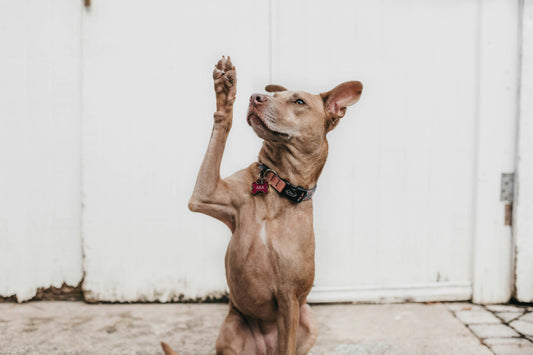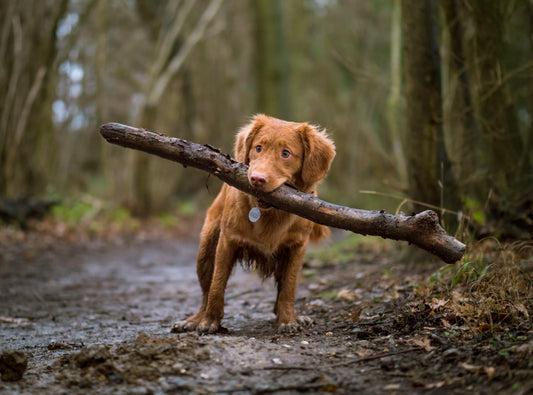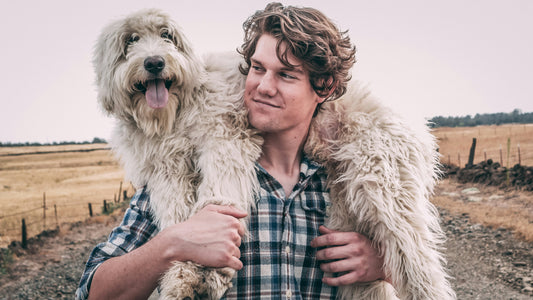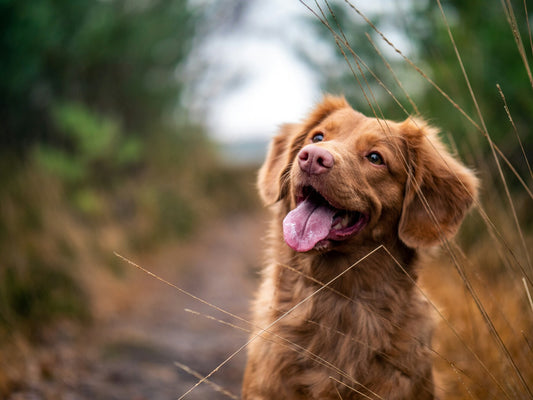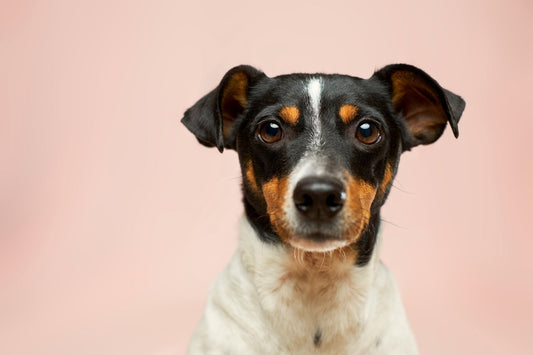How to Calm a Dog During a Storm

With the rumble of thunder and the unpredictable flashes of lightning, storm season can be particularly disturbing for dogs. Witnessing thunderstorm anxiety in your companion is a challenging experience.
In this article, we’ll give you tips to bring serenity back into your dog’s mind when the skies turn tempestuous. Every dog reacts differently to a storm, but understanding the “why” and knowing the “how” can reduce your dog’s distress.
Recognizing Storm Anxiety in Dogs
Every pet owner knows their dog’s body language speaks volumes. Before effectively addressing storm anxiety, it’s crucial to discern the telltale signs. Physical manifestations like pacing, trembling, and excessive drooling can indicate heightened stress levels.
On the behavioral front, dogs might seek refuge in concealed spots, showcase vocal expressions of distress, or, in some cases, adopt destructive habits. Chronic indications, such as persistent avoidance behavior even after the storm has passed, point towards long-term anxiety issues that require attention.
Moreover, understanding these reactions provides insight into the severity of the anxiety. While some dogs might just display subtle signs of discomfort, others may have heightened reactions that need immediate intervention. Recognizing these symptoms early ensures that your pet doesn’t suffer unduly when the next storm rolls in.
Why Are Dogs Afraid of Storms?
Dogs possess acute senses which make them highly receptive to their surroundings. One major culprit behind a dog’s fear during thunderstorms is their sensitivity to barometric pressure changes, making them aware of an impending storm even before humans can notice. The thunder’s loud roars and static electricity’s sensation can be disorienting and terrifying for many dogs. Their high sensitivity to sound can also lead to firework anxiety.
Past experiences also play an important role. A dog that’s had a traumatic event during a storm, be it getting trapped outside or being alone at home, might associate all subsequent storms with that fear. It’s essential to recognize these fears to appropriately address and alleviate them.
Also read: How to Stop Dogs from Scratching Doors
Preparing in Advance: Making Storms Less Stressful
Storms might be unpredictable, but our response to them shouldn’t be. One of the most effective preventive measures is setting up a ‘safe space‘—an area where your dog feels secure and insulated from the storm’s disturbances. This could be a corner of a room, a closet, or even under a table, draped with blankets for added comfort.
But introducing this space to your dog abruptly during a storm wouldn’t be very effective. Hence, it’s essential to familiarize your dog with this sanctuary during calm weather. Playing soft music or employing white noise machines can help mask the storm’s sounds, offering a soothing environment for your pet. Classical music, in particular, has been observed to have a calming effect on many dogs.
Moreover, consistently rewarding calm behavior during peaceful times can lead to positive associations. When the storm season arrives, your dog will recognize this safe space as a haven, providing a sense of familiarity and comfort amidst the chaos.
Immediate Solutions: How to Calm a Dog During a Storm
When the storm is already upon you and your pet is displaying signs of distress, immediate intervention is key. One renowned solution is the use of pressure wraps or thunder shirts. By applying gentle, consistent pressure, these wraps emulate the comforting feeling of being swaddled, helping to soothe the dog’s anxiety.
Distractions can also serve as valuable tools. Engage your dog with their favorite toys or provide them with treats. This not only takes their mind off the storm but can also lead to positive reinforcement, as they begin to associate storms with treats or playtime.
While it’s instinctual to comfort your pet, it’s crucial to ensure that you’re not inadvertently reinforcing their fearful behavior. Staying calm and offering a reassuring presence can help your dog understand that there’s no imminent threat.
Long-Term Strategies to Alleviate Storm Anxiety
It’s essential to acknowledge that while immediate solutions offer temporary relief, addressing your dog’s fear at its root requires a more prolonged approach. For dogs with heightened storm anxiety, adopting long-term strategies becomes imperative.
Behavioral training methods, for instance, have proven efficacious. Through consistent positive reinforcement, desensitization techniques gradually introduce and acclimate dogs to storm sounds, lessening their anxiety over time.
However, the severity of the thunderstorm anxiety in some dogs may require a visit to the vet. They might recommend calming supplements or even specific anti-anxiety medications to manage the dog’s stress. While these can be effective, it’s crucial always to consult with a professional before administering any medication.
In particularly severe cases, involving a professional dog trainer or considering therapy can be beneficial. These experts can provide tailored strategies and techniques to help your dog cope better.
The Role of Natural Calming Supplements and Treats
Natural calming supplements can be an excellent alternative to heavy medication, especially for dogs that experience milder anxiety. These supplements often incorporate ingredients like chamomile, valerian root, and L-theanine, all of which are renowned for their calming properties.
Treats infused with these ingredients satiate your dog’s palate but also serve a dual purpose by helping to soothe their nerves. When choosing these products, it’s essential to opt for reputable brands known for their efficacy. Always ensure you’re administering the right dosage and monitor your dog for any adverse reactions.
When to Seek Professional Help
While many pet owners manage their dog’s thunderstorm anxiety with the strategies mentioned, there are times when it’s vital to seek expert intervention. If you observe that your dog’s body language becomes particularly tense, their destructive behavior escalates, or if their fear seems to paralyze them, it might be indicative of extreme anxiety.
The benefits of consulting a vet or a professional dog trainer are manifold. A vet can offer insights into potential underlying health issues contributing to the heightened anxiety and prescribe appropriate treatments. On the other hand, dog trainers possess expertise in behavioral modification techniques tailored to each dog’s unique needs.
It cannot be emphasized enough that prolonged severe anxiety isn’t just distressing for your dog; it can manifest into long-term health issues. Thus, it’s crucial not to ignore or downplay the severity of their fears. Seeking professional guidance early can make a world of difference to your dog’s well-being and quality of life.
Preventative Measures: Building a Storm-Ready Routine
Preparing in advance is one of the best ways to help alleviate your dog’s anxiety during storm season. Many dogs find peace in predictability, and by establishing a consistent routine, you can help them navigate the often overwhelming sensations that come with thunderstorms. Being proactive, rather than reactive, will ensure your furry friend feels safer.
Staying updated on weather forecasts isn’t just about planning your day; it can be instrumental in preemptively managing your dog’s thunderstorm anxiety. By knowing when a storm is on the horizon, you can adjust your routine, ensuring you’re home to comfort them or setting up their safe space with their favorite toys and classical music to soothe them.
Furthermore, introducing new calming techniques gradually is essential. Every dog is unique, and what works wonders for one might not have the same effect on another. Testing out different methods during calm weather can help you identify what’s most effective for your dog, ensuring they have the best possible comfort when the storm hits.
Schedule a Consultation with our Team of Experts
If you're looking for help to get your dog's storm anxiety under control, our team of experts is here to provide personalized advice and support.
Whether you need help with training techniques, or behavior modification, or simply want to discuss the best approach for your dog, we’re here to help. Book a consultation call with us today, and take the first step towards stopping your dog’s door-scratching behavior for good.

